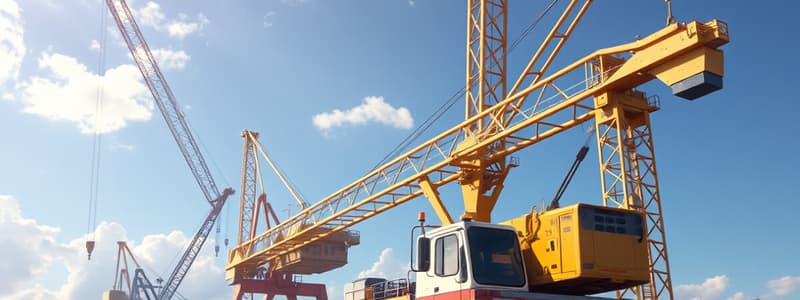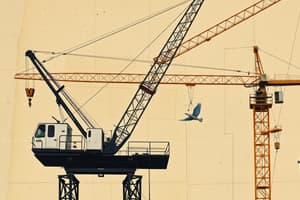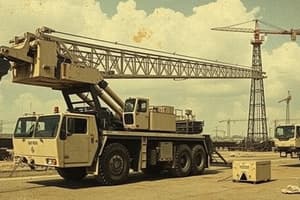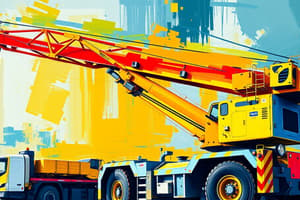Podcast
Questions and Answers
What is NOT included in the defined scope of mobile crane examination?
What is NOT included in the defined scope of mobile crane examination?
- Tyres and wheels
- Slewing mechanism examination
- Manufacturer’s information plate/label
- Environmental temperature monitoring (correct)
Which component is specifically inspected for its full range of movement during crane examination?
Which component is specifically inspected for its full range of movement during crane examination?
- Slew section structure
- Outrigger jacks
- Hydraulic oil level
- Slewing mechanism (correct)
Which of the following components does NOT require a visual inspection?
Which of the following components does NOT require a visual inspection?
- Hydraulic cylinder fittings
- Control system wires (correct)
- Superstructure and jib
- Falling object protection structure
What is one of the purposes of the chassis braking system examination?
What is one of the purposes of the chassis braking system examination?
The examination of which component helps prevent load overshoot during crane operations?
The examination of which component helps prevent load overshoot during crane operations?
What is the significance of inspecting the cab of the crane?
What is the significance of inspecting the cab of the crane?
Which of these is NOT a characteristic of hook block examination?
Which of these is NOT a characteristic of hook block examination?
What does the telescoping extension on the crane need to be checked for?
What does the telescoping extension on the crane need to be checked for?
What is the primary purpose of a pre-use inspection?
What is the primary purpose of a pre-use inspection?
Which of the following is NOT involved in a pre-use inspection of cranes?
Which of the following is NOT involved in a pre-use inspection of cranes?
Interim inspections are primarily determined by which factor?
Interim inspections are primarily determined by which factor?
What is a common practice during interim inspections?
What is a common practice during interim inspections?
What defines the frequency of interim inspections?
What defines the frequency of interim inspections?
Which aspect is NOT covered during a pre-use crane inspection?
Which aspect is NOT covered during a pre-use crane inspection?
Who is responsible for conducting the pre-use inspection?
Who is responsible for conducting the pre-use inspection?
What is a key factor to consider during an interim inspection?
What is a key factor to consider during an interim inspection?
What should be ensured about the operator's seat during a cab inspection?
What should be ensured about the operator's seat during a cab inspection?
Which of the following should be checked in relation to the crane controls?
Which of the following should be checked in relation to the crane controls?
What is an important aspect to check regarding the cab's visibility?
What is an important aspect to check regarding the cab's visibility?
What should be verified about the RCL (Rated Capacity Limiter) during an inspection?
What should be verified about the RCL (Rated Capacity Limiter) during an inspection?
What condition is acceptable for the windscreen wipers during an inspection?
What condition is acceptable for the windscreen wipers during an inspection?
Which of the following is NOT a cab inspection requirement?
Which of the following is NOT a cab inspection requirement?
During the tilt cab mechanism inspection, what should be confirmed?
During the tilt cab mechanism inspection, what should be confirmed?
What should be included in the checks concerning air conditioning and heater controls?
What should be included in the checks concerning air conditioning and heater controls?
Flashcards
Chassis and tyres
Chassis and tyres
Mobile cranes rely on these for operational safety.
Regular examinations
Regular examinations
Essential for safety compliance in mobile cranes.
Manufacturer’s information plate/label and duty charts
Manufacturer’s information plate/label and duty charts
Must be checked for accurate load handling information.
Tyres, wheels, and axle locking systems
Tyres, wheels, and axle locking systems
Signup and view all the flashcards
Crawler tracks and crane chassis
Crawler tracks and crane chassis
Signup and view all the flashcards
Outrigger jacks and beams
Outrigger jacks and beams
Signup and view all the flashcards
Bolts, pins, and fastenings
Bolts, pins, and fastenings
Signup and view all the flashcards
Slew section
Slew section
Signup and view all the flashcards
Pipework, hoses, and hydraulic cylinder fittings
Pipework, hoses, and hydraulic cylinder fittings
Signup and view all the flashcards
Superstructure, jib, fly jib, and mounting attachment
Superstructure, jib, fly jib, and mounting attachment
Signup and view all the flashcards
Wire running and static ropes
Wire running and static ropes
Signup and view all the flashcards
Pulleys, sheaves, and drums
Pulleys, sheaves, and drums
Signup and view all the flashcards
Crane cab
Crane cab
Signup and view all the flashcards
Falling object protection structure (FOPS)
Falling object protection structure (FOPS)
Signup and view all the flashcards
Limiting and indicating devices
Limiting and indicating devices
Signup and view all the flashcards
Hook blocks
Hook blocks
Signup and view all the flashcards
Hoist, luffing
Hoist, luffing
Signup and view all the flashcards
Markings, labels, and instruction notices
Markings, labels, and instruction notices
Signup and view all the flashcards
Pre-use inspection
Pre-use inspection
Signup and view all the flashcards
Interim inspection
Interim inspection
Signup and view all the flashcards
No obstructions
No obstructions
Signup and view all the flashcards
Loose wires or panels
Loose wires or panels
Signup and view all the flashcards
Rated capacity limiter (RCL)
Rated capacity limiter (RCL)
Signup and view all the flashcards
Crane-specific load charts
Crane-specific load charts
Signup and view all the flashcards
Study Notes
Mobile Crane Safety and Examination
- Mobile cranes depend on chassis and tyres for operational safety; both components are critical to the crane system's integrity.
- Regular and thorough examinations of mobile cranes are essential for safety compliance.
Examination Components
- Manufacturer’s information plate/label and duty charts must be checked.
- Inspect tyres, wheels, and axle locking systems for wear or damage.
- Crawler tracks and crane chassis should be examined closely.
- Outrigger jacks and beams, along with chassis braking systems, require inspection.
- Conduct a visual inspection of bolts, pins, and fastenings to ensure stability.
- The slew section structure, including fasteners and slew ring, must be inspected.
- Assess the slewing mechanism throughout its full movement range with the jib extended.
- All pipework, rigid and flexible hoses, and hydraulic cylinder fittings should be visually checked.
- Visual checks of oil levels and fluid condition are necessary.
- Superstructure, jib, fly jib, and mounting attachment require visual inspections.
- Inspect all pivoting joints and telescoping extensions on the crane.
- Check wire running and static ropes for integrity at terminations.
- Inspect pulleys, sheaves, and drums including protective guards.
- The cab should be fully inspected, focusing on controls, markings, indicators, and seating.
- Check the falling object protection structure (FOPS) and associated components.
- Limiting and indicating devices like rated capacity systems and anemometers must be functional.
- Hook blocks, counterweights, and all fastening mechanisms should be closely examined.
- Hoist, luffing winches, brakes, and hydraulic systems require inspection.
- Inspect power and control cables, slip rings, and ensure control cabinets are intact.
- Verify that all markings, labels, and instruction notices are present and legible.
Levels of Inspection
- Pre-use inspection: Carried out by the crane operator to identify any obvious defects or functionality issues. Competency in conducting these checks is crucial, necessitating training and assessment.
- Interim inspection: Also known as "In-Service inspection," determined by risk assessment focusing on critical components. Frequency can vary based on risk and manufacturer guidelines, often occurring during maintenance or repairs.
Operator and Cab Controls Checks
- Maintain a tidy cab; clutter can hinder safety and functionality.
- Ensure the operator’s seat is in good condition and functions correctly.
- Check for loose wires or panels to avoid electrical hazards.
- Ensure the rated capacity limiter (RCL) is fully functional.
- Verify crane-specific load charts are present in the cab.
- Ensure no obstructions impede the operator's view.
- Confirm safety glass is intact and only manufacturer-specific glass is used.
- All control functions, switches, lights, and air conditioning/heater controls must operate correctly.
Crane Control Functionality
- Verify that all control functions and switches are clearly marked and perform as intended for safe operation.
Studying That Suits You
Use AI to generate personalized quizzes and flashcards to suit your learning preferences.




